If you're looking for the top things to do and see while visiting the Island of Hawaii, aka Big Island, then we've got you covered! Below we share where to stay, the best beaches to visit, the best places to eat, less touristy activities, and all of our Big Island adventures.
As the name states, Big Island is very BIG! If you are planning on seeing and experiencing the top things the island has to offer, be prepared for a lot of driving, and spending at least five to seven days on the island. Although you will be driving to explore different parts of the island, the drives are all beautiful, and you will not encounter much traffic.
About Big Island
Big Island is the largest and youngest of the Hawaii Islands. It is, in fact, the largest island in the United States, covering 4,029 square miles. The island is continuing to grow at a slow rate due to active volcanic activity. The island is home to six volcanoes, and two of the six are still active, Kilauea and Mauna Loa. When we say active, we mean so active that we were on the island for the most recent Kilauea eruption at Halemaumau Crater on December 20, 2020.
(We will share more on the eruption in our Hawai'i Volcanoes National Park blog post.)
Big Island is made up of six regions: Kona, Kohala, Hamakua Coast, Hilo, Puna, and Kau.

The island is comprised of several climate zones ranging from rainforest to frozen tundra to the desert. Due to such a wide variation, rainfall across the island varies significantly on location. The east side of the island, Hilo, gets approximately 125 inches of rain a year and rains almost daily, while the Kona side of the island, or the west side, receives only 25 inches of rain a year and is often sunny and dry. When driving across the island, the various terrains directly reflect the climate zones, lush rainforests on the east side and dry, brown terrains on the west side.
Although the island is most famously known for its volcanoes, black sand beaches, and stunning waterfalls, it is also known for Kona coffee. Most of the island's coffee is grown in the Kona region due to its sunny weather, volcanic soil, and occasional rain. When exploring the island, you will find dozens of different Kona coffee plantations on the island's west side.
After spending seven adventure-packed days on Big Island, we discovered there is so much more than volcanoes, beaches, and coffee. The island is quite a bit more laid back than Oahu, the waterfalls are much larger, and the varied terrains are quite the sight to see. Driving along parts of the island felt similar to a Costa Rican rainforest, while other parts felt similar to driving across a Nevada Dessert or hiking a mountain in Wyoming.
It truly is an amazing island with something for everyone!
Looking for more Big Island ideas?
Hunting Hawaiian Black Sheep and Spanish Goat on the Big Island
Top Places to Eat on the Big Island
*Disclaimer before we continue and share our favorite Big Island adventures: we currently live on Oahu and thus get more than enough beach adventures on our home island; we additionally are not a hang out at the beach all day type of family. We love to spend our days snorkeling, hiking, eating, and exploring the unique character of the towns we visit.
General Tips and Preparing For Your Visit
-Research your top adventures and plan your stay based on the distance to most of the adventures you choose (you will still spend some time driving, however establishing a game plan will avoid any unnecessary driving during your visit).
See pros/cons of where to stay below!
- Best time of year to visit:
The island has two main seasons, wet and dry. The wet season is typically between November-April and the dry season between May-October. We visited the week before Christmas in December, and although we experienced a fair amount of rain on the Hilo side of the island, we had plenty of sunshine during our day trips to Kona and Captain Cook.
**Note that the waters can be a bit rougher during the December-March months; however, there are still plenty of bays and coves that are calm all year round.
Keep in mind that holidays and summer months are often more expensive and more crowded times to visit the island. Flights and rental cars will often be more pricey during these peak times.

-Getting to the island:
Big Island has two airports, one in Kona and one in Hilo. Kona is the more popular of the two airports, as more visitors typically stay on the Kona side of the island.
**Regardless of which side of the island you choose to stay on, renting a car is a must! It is recommended to rent a 4-wheel drive or all-wheel drive vehicle if you plan to drive to Green Sands Beach, Waipio Valley, or up to the summit of Mauna Kea. We saved some money and opted to rent a standard all-wheel drive SUV to meet our family's needs while on the island. While jeeps are often a popular rental choice when visiting any of the Hawaii islands, they are often more expensive to rent and not usually necessary!
-Bring a rain jacket! We stayed on the Hilo (east side) of the island, and it rained daily. While it did not rain all day, we were certainly glad we had thin rain jackets to throw on while we were exploring.
- If you plan on doing any hikes, bring hiking shoes or tennis shoes with good grip; Hawaii terrains are often slippery due to rain or dry, loose rocks.
Pros/Cons: Where to stay on Big Island
The two main areas to stay are Hilo and Kona, Kona being the more touristy and popular option.
Hilo:
-Pros: Closer to Hawai'i Volcanoes National Park, closer to Waterfalls and Waipio Valley, less touristy feeling, lush and green rainforest terrains, more local character and restaurants
-Cons: No white sand beaches, fewer resort options, more rainfall
Kona:
Pros: White sand beaches, more resorts and shops, closer to coffee farms, snorkeling and manta ray swim, less rain
Cons: More touristy and crowded, not walkable
As mentioned above, it really depends on what type of adventures you wish to experience on the island when deciding where to stay. The distance between both sides of the island is about 1.5 hours. Some visitors choose to split their time in Kona and Hilo; however, we chose not to do this as packing up a family of 4 and switching hotels mid-trip was not something we wanted to do.
We stayed at the Grand Naniloa Hotel Hilo. We focused most of our time on the east and south sides of the island visiting the volcanoes, rainforests, waterfalls, black sand beaches, Waipio Valley, and local shops. We traveled to Kona and Captain Cook a few of the days to snorkel at Captain Cook, swim with the manta rays, visit coffee farms, and my husband squeezed in a sheep and goat hunt.
It is certainly doable to stay on one side and still experience everything the island offers if you do not want to split your trip.
Our 7-Day Itinerary on the Big Island
Day 1: Hilo
We arrived on the island bright and early (7:30 am) to make the most of our day! We were able to drop off our luggage at our hotel and then headed out to explore.
1. Our first stop was Rainbow Falls. Although we did not catch a rainbow on our visit, the history of the falls (Battle of the Wailuku River) and easy to visit lookout was a great start to our day.

2. After a quick visit to the falls, we stopped to grab some coffee, kombucha, and food at The Booch Bar Hilo. This is a great spot for fresh, local, and healthy food options in downtown Hilo.

3. The next stop on our Day 1 adventures was Hawai'i Volcano National Park. At the park, we visited the Crater Rim Trail, explored some of the steam vents, visited the Kilauea lookout over Halema'uma'u, and completed the Kilauea Iki Trail.
For a more detailed breakdown of our Hawai'i Volcano National Park visit, check out our post here!
4. We made one last stop at Akaka Falls. A quick 0.4-mile loop through lush the lush rainforest to the island's most popular waterfall! Akaka Falls plunges 442 feet to the bottom and is most certainly worth a visit. Along the short loop, you will also pass a lookout point for the cascading Kahuna Falls. This hike is along a paved, easy-to- follow path and takes less than 30 minutes to complete.
5. We enjoyed dinner at Pineapples Island Fresh Cuisine. The open-air restaurant has locally inspired food options and is also known for their refreshing cocktails served in a pineapple for an extra island treat!
Day 2: Hilo to Kona Along the Coast
After a quick breakfast at the hotel, we began day two, traveling along the island's eastern and southern coasts.
1. Our first stop was at Punalu'u Black Sand Beach, located about an hour from our hotel. After spending plenty of time visiting Oahu's white-sand beaches, it was quite interesting walking along the black sand at Punalu'u Beach. The waters were very rough and not suitable for swimming; however, it was mesmerizing to watch the waves crash into the lava rock formations along the shore.
We also spotted twelve green turtles sunbathing along the beach. There are almost always green turtles at this beach; please be respectful and keep your distance if you spot some on your visit!
2. After our short beach visit, we ventured on to South Point Park. Here we walked out to the southernmost tip of the island and the United States. The Florida Keys often claim this title; however, South Point Park's tip is technically the United State's southernmost tip.
The entire southernmost tip is registered as a National Historic Landmark, as it is scattered with fishing shrines, ruins, and other cultural relics. The tip has endless views of the Pacific Ocean and even has a jumping rock for those brave enough to hop off the cliff and climb back up an old, rusty ladder!
Just past South Point Park is the Green Sand Beach (Papakolea) trailhead. It is about a 2-mile hike down to the beach and 2 miles back up, or there are usually locals willing to drive you down the rough terrain for a little bit of cash. We chose not to visit the Green Sand Beach as we were running out of time, but it may be something unique to see on your visit!
3. As we continued on our coastal tour, we made our way towards Kona to prepare for our manta ray night swim. Along the way, we enjoyed a late lunch at Shaka Tacoz.
If there is one adventure to splurge on during your Big Island visit, the manta ray night swim is it! Since living in Hawaii, we have had the opportunity to experience some incredible adventures, and this is most certainly at the top of our list! We booked our manta ray swim through Hang Loose Boat Tours, and we highly recommend them.
**Read more about our bucket list experience and what to expect when swimming with the Manta Rays in Kona on our blog post here!
After finishing up the swim, we enjoyed our long drive back to Hilo star gazing along the way and conversing about how surreal of an adventure the manta ray swim was!
Day 3: Hilo and Waipio Valley
After a late-night following our manta ray swim, we took our time in the morning and headed out for an authentic Hawaiian breakfast.
1. If you are staying in Hilo, or even visiting Hilo for the day, be sure to check out Hawaiian Style Cafe Hilo. Come hungry as their portions are huge, and be sure to order the Haupia Pancakes and Hawaiian Sweet Bread French Toast. They are also open for lunch and dinner, and conveniently located in a shopping center with plenty of parking.
2. Once our bellies were full, we headed to Honokaa (about 1hour from Hilo) and hopped on our Waipio Valley Shuttle Tour. Waipio Valley is a popular sight to see on the Hamakua Coast of Big Island, and it is easy to understand why.
Waipio Valley was once home to the king of ancient Hawaii and served as a retreat for Hawaiian royalty. Waipio Valley was discovered in 1823 and was adorned with taro patches, banana trees, fish ponds, several heiau, and a place of refuge, Pakaalana. Approximately 1,500 residents farmed the land and participated in leisurely activities, including fishing, swimming, and celebrations (luaus). Today, a few residents continue to operate taro farms in the pastoral valley, and wild horses roam freely amongst the freshwater rivers, fruit trees, and sandy beaches. The valley is also home to one of the tallest waterfalls on the island!
The valley is accessible by driving down to the bottom (4x4 required), hiking down (6.5 miles round trip), or taking a shuttle tour. We highly recommend taking a tour as the road is very steep (25%-40% grade) and very narrow. Additionally, there are several rivers to cross, and the shuttle guides have more experience and knowledge on when it is safe to cross the rivers. Our guide Gary was very knowledgeable and had a first-hand perspective of the valley as he grew up in the area.
3. After our tour, we spent some time walking through downtown Honokaa and grabbed lunch at Gramma's Kitchen and coffee at Papaaloa Joe Coffee.
4. While making our way back to Hilo, we made two more stops at the Kaumana Caves and the Boiling Pots. Both are quick stops and certainly worthwhile visiting!
-Kaumana Caves are lava tubes created by an 1881 eruption of Mauna Loa. There are two caves that are easily accessible down a flight of well-maintained stairs. The caves are very dark and wet, so be sure to bring a flashlight, tennis shoes with good grip, and a rain jacket; we used our iPhone flashlights and managed fine; however, we did not venture too far into the caves.
-The Boiling Pots, and Pe'epe'e Falls, are a section of the Wailuku River. When the river is engorged with stormwater, the river rises, and water in the terraced pools appear to be boiling. These falls are beautiful to view from a well-maintained platform that is easily accessible.
(It is incredibly unsafe to swim in the pools below as flash flooding is common along the river, and the intense cascade of the falls has a history of trapping people in the pools.)
5. Following another fantastic day of exploring, we enjoyed a nice dinner at Jackie Rey's Ohana Grill Hilo.
Day 4: Captain Cook Hike and Snorkeling at Kealahehua Bay
1. We started our morning grabbing a quick bite to eat and some of the best coffee Hilo has to offer from Just Cruisin Coffee. In addition to great coffee options, they also have delicious food options, and their drive through made it convenient to grab breakfast on the go.

2. After our quick breakfast stop, we continued to Captain Cook to hike the Captain Cook's Monument Trail. A 4-mile trek to the best snorkeling spot on the Big Island!
After our 1 hour hike down to Kealahehua Bay, we made a quick stop at the location where Captain James Cook met his death in 1779; and then continued to the Captain Cook Monument, built in 1874, commemorating the fallen British explorer. The monument is only accessible by foot, kayak or boat.
We spent a few minutes checking out the monuments and getting our snorkel gear prepared, and then we were ready to jump in! Kealahehua Bay is said to be the best snorkeling spot on the island, and we could not agree more. The water was crystal clear, and there was an abundance of fish everywhere. We did not spot any dolphins during our time in the water; however, many swimmers have frequently reported spinner dolphin sightings in the bay.

After spending about an hour in the water, we toweled off and prepared to head back up the trail to our car. It was hot, we were all tired, and the steady 1,256ft elevation gain made the trip back up much harder than the trip down.
We took our time (~2hrs), enjoyed watching the wild goats roaming nearby, and made frequent rest breaks. Although the hike was challenging, the snorkeling experience at Kealaheuhua Bay was 100% worth it!
Here are a few tips to help you prepare for your visit to Captain Cook Monument and Kealaheuhua Bay:
- Allow for at least half a day to complete the hike and snorkel.
Captain Cook's Monument trail is rated "hard" on All Trails due to its uneven terrains and challenging climb back up the trail when ascending the 1,256 elevation gain. The trail took us about an hour to hike down to the monument and Kealahehua Bay, and about 1.5-2 hours to hike back up to our car.
- What to bring: We recommend wearing your bathing suits and good hiking shoes, packing towels, snorkel gear, a change of clothes, and at least two large bottles of water.
(Be sure to pack more water than you think you will need, we ran out towards the end of our hike back to our car.)
We *highly* recommend wearing supportive shoes over sandals on this trail. The uneven rocks are certainly not safe in sandals or shoes without support.
If you do not plan to bring fins to snorkel with, we recommend bringing water shoes as sea urchins can be found on a lot of the coral.
- Parking: there is street parking along the road across from the trailhead. Look for two no parking signs to find the start of the trail. You will know you're on the right path when you come across an abandoned jeep.
- The trail is straightforward and marked by eight trail markers. When you get to the bottom of the trail, you will find a small area with rock formations and water straight ahead; this is where the small monument is located.
To access the large monument and snorkeling area, turn left at the tree arch and park sign (below); you will see the tall, white monument ahead and snorkelers in the water.

(If you are an experienced hiker, this trail may be more moderate than hard; however, the loose rocks, uneven lava formations, as well as consistent elevation gain, make this trail harder than it appears.)
4. Following our long day of hiking and snorkeling, we made our way back to our hotel in Hilo and opted for a quick take out dinner.
Day 5: Exploring Hilo
On day 5, my husband headed out to check off one of his Hawaii bucket list items, a two-day hunt with Nahele Outfitters. If you or your significant other is into hunting and looking for a unique Big Island experience, we cannot recommend Nahele Outfitters enough! For more details of my husband's hunting experience, check it out on his post here. (Coming soon!)
1. The kids and I decided to explore more of Hilo and have a slower and relaxing day. We started our day enjoying fresh açaí bowls at Makani's Magic Pineapple Shack. If you're looking for a sweet spot with fresh bowls, smoothies, and treats, be sure to visit Makani's Magic Pineapple Shack at least once on your visit.
2. We checked out the Hilo's Farmer's Market next. Although the market was not as full as it usually is (pre-covid), we still managed to purchase some local fruits and jewelry souvenirs. The market was fun to walk through and look at all of the colorful, local fruits and vegetables.
3. Following the market, we headed to Lili'uokalani Park and Gardens. The kids and I enjoyed exploring the various bridges, ponds, Japanese gardens, pagodas, and statues. The Lili'uokalani Gardens are incredibly serene and make a great spot to visit in Hilo.
4. After exploring all of the gardens, we headed to Vibe to grab a quick bite to eat before heading back to the hotel. If you are a vegan, vegetarian, or just looking for a healthier food option in Hilo, be sure to check out Vibe.
5. We ended our evening eating a light dinner at the hotel restaurant, Hula Hulas. I do not recommend this restaurant if you are looking for something with a good variety and a nicer ambiance. They currently have a very limited menu, and the food options we chose were just okay.
Day 6: Coffee Farms and Place of Refuge
1. On day 6, the kids and I took our time getting going before spending the day exploring more of Kona. We started the morning off with delicious breakfast sandwiches from Just Cruisin' Coffee, and I enjoyed one of their holiday specialty coffees!
2. We headed to the Kona area to do some more exploring and sightseeing before picking up my husband from his hunting adventure.
Our first stop along the way was Greenwell Farms. If you are a coffee drinker or have any interest in how coffee is grown and processed, I highly recommend checking out Greenwell Farms. There are several Kona coffee farms in a small vicinity; however, we were told Greenwell Farms provides the best tour of their farm, and the best part it is free! Their farm has been producing coffee beans since the 1850s, and they are one of the most successful Kona coffee distributors in the area.
- Their tour takes approximately 45 minutes, and they share with guests the entire process of producing coffee from seed to cup. After the tour, guests can sample some of the best Kona coffee on the island and shop around their gift shop.
Although the kids and I only visited one coffee farm, some other popular farms to visit are Heavenly Hawaiian Coffee Farm and Buddha's Coffee. While I would have loved to visit one more coffee farm, the kids were much less interested and ready to move on to our next adventure!
3. Following our coffee Farm visit, we ventured on to Pu'uhonua O Honaunau National Historical Park, also known as the Place of Refuge. While we were planning our Big Island trip, our daughter shared some of the Hawaiian history she was learning in school, including the Place of Refuge. The historical park is home to some of the most significant Hawaiian sites and landmarks and is a great place to learn more about the Hawaiian culture. Although the park is currently open, they are not providing tours or demonstrations at this time due to covid-19 restrictions. Touring the grounds and exploring the place of refuge was still very educational and fascinating to visit.
If you are interested in snorkeling and looking for easier beach access, Two Steps (Honaunau Bay) is another popular snorkeling spot on the island, and is located next to the park. This snorkel location can often be crowded due to its easy access and accessible parking, but is still a great option to explore some of the sea life in Hawaii.
4. For lunch, we headed to Black Rock Pizza in Captain Cook. Newer to the Captain Cook area, this pizzeria was delicious and the perfect, kid-friendly option to eat. We enjoyed the large outdoor seating area, and the kids enjoyed doodling on their chalkboard wall. Black Rock Pizza is a great, family-friendly food option near the Kona area.
5. After enjoying way too much pizza, we continued to explore the Kona area and used the Gypsy Guide app to guide us around and provide interesting information about the town.
We highly recommend purchasing the Gypsy Guide app when visiting Big Island or any of the Hawaiian Islands. As we have mentioned several times, you will be driving (a lot!) on Big Island. The Gyspsy Guide provides entertaining stories, history, geology, native animals, hikes, and cultural highlights along your driving route. It provides helpful information and suggests stops along your drive that you may have otherwise missed.
6. Our final stop in Kona was dinner at Broke Da Mouth Grindz. The restaurant is not fancy, but if you are looking for authentic Korean and Hawaiian food, this is a great spot. They have anything from laulau, kailua pork, kalbi, and kimchi; however, they are best known for their furikake chicken!

Day 7: Mauna Kea and Departure Back to Oahu
1. On our final day, we planned to visit Mauna Kea; however, we contemplated heading back to see the erupted volcano in Hawai'i Volcanoes National Park. After doing some research and learning about the increased wait times to view the volcano and suggested times to view the lava, we decided to stick to our original plan and head to Mauna Kea. We are so glad we made this decision, as Mauna Kea was one of the most breathtaking sites we visited on the island! If you are considering visiting Mauna Kea, we highly recommend you put it as a "must-see" on your list.
Mauna Kea, one of Hawaii's dormant volcanoes, is the world's tallest mountain when measured from its underwater base. (33, 500 ft in height) The volcano is about one million years old and has passed the most active stage of life thousands of years ago. A majority of the volcano is underwater; however, its peak is 13, 803ft above sea level, making it the tallest point in the state of Hawai'i and a popular site to visit.
Most frequently visited at sunset and nighttime for star gazing, the volcano is quite spectacular to see at any point in the day. When visiting, it is recommended to stop at the visitor center located at 9,200ft to acclimate to the altitude change, check for weather updates, and receive safety information. We recommend checking their visitor page before your visit to be sure there are no road closures and to prepare for any inclement weather. It is not recommended that people in poor health, women who are pregnant or children under the age of 13, travel to the summit due to altitude sickness concerns.
We chose to follow the summit information page's recommendations and did not proceed past the visitor center with our young children. Although we did not go to the summit, the views from above the clouds were simply indescribable.
There are several short hikes near the visitor center, and we chose to hike up the Mauna Kea Visitor Center Sunset Hill Trail. The trail is 1.2 miles round trip and provides clear panoramic views a the top. The trail is easy to follow and is a steady incline up a dirt path to the top.
If Mauna Kea is on your list of places to visit on the Big Island (it should be!), we highly recommend making the quick hike up to the top of the hill.
After spending a few hours at Mauna Kea, we made our way back down and prepared for our flight back to Oahu.
Although we were on the go most of our 7-day trip, we truly feel we experienced the top adventures that the Big Island has to offer!
Adventures Recap:
-Hawaii Volcanoes National Park-Crater Rim Trail, Stem vents, Kilauea Iki Trail
-Waterfalls- Rainbow Falls, Akaka Falls
-Waipio Valley Tour
-Black Sand beach, Southernmost tip
- Boiling Pots and Kaumana Caves
-Captain Cook Monument Trail and snorkeling at Kealahehua Bay
-Place of Refuge
-Greenwell Farms coffee tour
-Mauna Kea
-Kona Manta Ray night swim
Food Recap:
-The Booch Bar
-Makini's Magic Pineapple Shack
-Shaka Tacoz
-Pineapples Island Fresh Cuisine
-Black Rock Pizza
-Vibe
-Just Cruisin' Coffee
-Broke Da Mouth Grindz
-Gramma's Kitchen
-Hawaiian Style Cafe
-Hilo Farmer's Market
Ready To Explore The Big Island?
Be sure to save or pin this post, and please feel free to share!























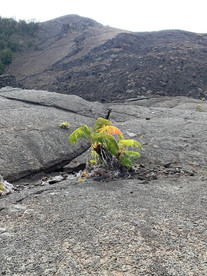































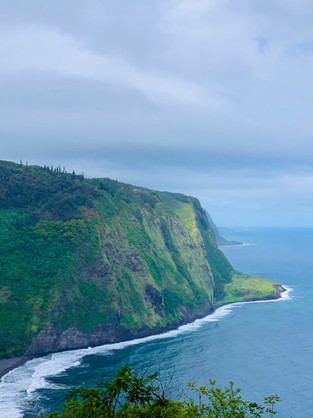



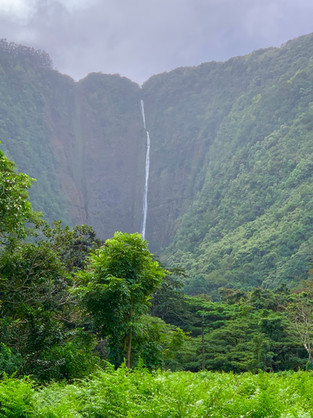

























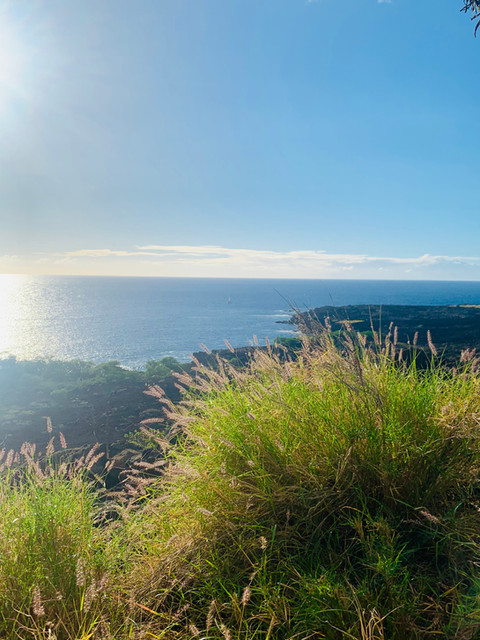































































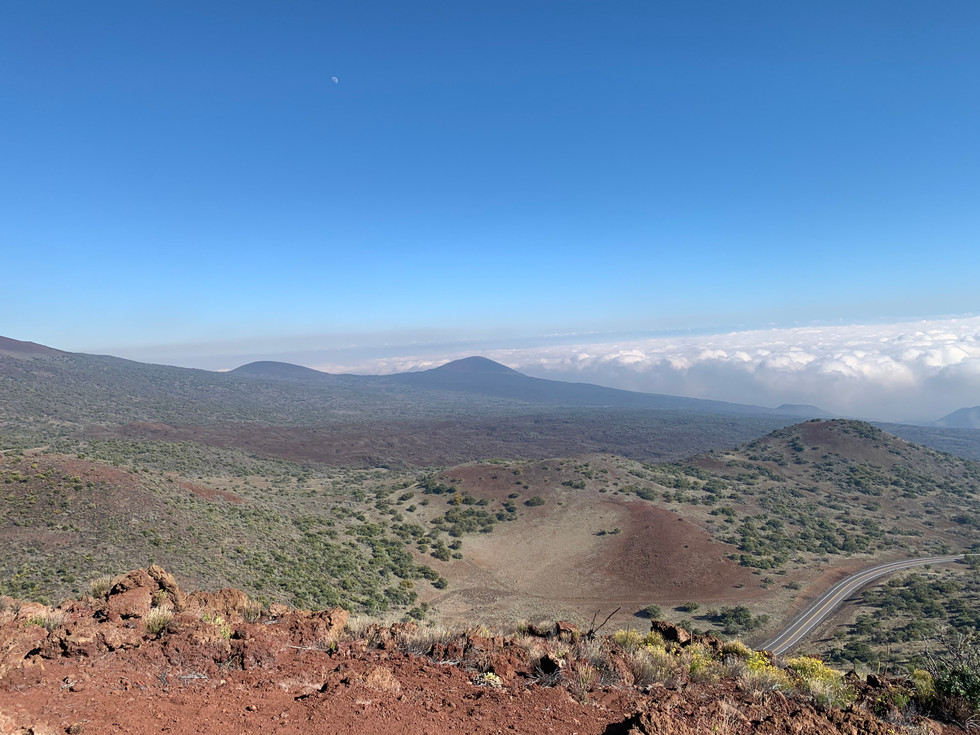
Comments